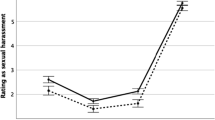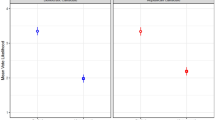Abstract
The purpose of this study was to examine factors that influence observers’ reporting of sexual harassment. Participants (N = 183) voluntarily took part in a 2 (harassment type: hostile environment, quid pro quo) × 2 (organizational culture: compliant, proactive) experiment. Results indicate that participants were more likely to respond assertively when observing quid pro quo harassment. Participant political orientation moderated the effects of both harassment type and culture. Persons with a more liberal political persuasion intended to respond assertively in situations where help might not otherwise be rendered (i.e., in compliant organizations and in hostile environment harassment). Contributions and implications are discussed.


Similar content being viewed by others
References
Bandura, A. (1999). Moral disengagement in the perpetuation of inhumanities. Personality and Social Psychology Review, 3, 193–209.
Bergman, M. E., Langhout, R. D., Palmieri, P. A., Cortina, L. M., & Fitzgerald, L. F. (2002). The (Un)reasonableness of reporting: antecedents and consequences of reporting sexual harassment. Journal of Applied Psychology, 87, 230–242.
Bowes-Sperry, L., & O’Leary-Kelly, A. M. (2005). To act or not to act: the dilemma faced by sexual harassment observers. Academy of Management Review, 30, 288–306.
Bowes-Sperry, L., & Powell, G. N. (1999). Observers’ reactions to social-sexual behavior at work: an ethical decision making perspective. Journal of Management, 25, 779–802.
Chan, D. K.-S., Lam, C. B., Chow, S. Y., & Cheung, S. F. (2008). Examining the job-related, psychological, and physical outcomes of workplace sexual harassment: a meta-analytic review. Psychology of Women Quarterly, 32, 362–376.
Conover, P. J., & Feldman, S. (2004). Reading 11. The origins and meanings of liberal/conservative self-identifications. In J. T. Jost & J. Sidanius (Eds.), Political psychology. Key readings in social psychology (pp. 200–216). New York: Psychology.
Cunningham, G. B. (2009). The moderating effect of diversity strategy on the relationship between racial diversity and organizational performance. Journal of Applied Social Psychology, 36, 1445–1460.
Cunningham, G. B., & Benavides-Espinoza, C. (2008). A trend analysis of sexual harassment claims: 1992–2006. Psychological Reports, 103, 779–782.
Dougherty, D. S., & Smythe, M. J. (2004). Sensemaking, organizational culture, and sexual harassment. Journal of Applied Communication Research, 32, 293–317.
Festinger, L., & Carlsmith, J. M. (1959). Cognitive consequences of forced compliance. Journal of Abnormal Social Psychology, 58, 203–210.
Fink, J. S., & Pastore, D. L. (1999). Diversity in sport? Utilizing the business literature to devise a comprehensive framework of diversity initiatives. Quest, 51, 310–327.
Fink, J. S., Pastore, D. L., & Riemer, H. A. (2001). Do differences make a difference? Managing diversity in Division IA intercollegiate athletics. Journal of Sport Management, 15, 10–50.
Fink, J. S., Pastore, D. L., & Riemer, H. A. (2003). Managing employee diversity: perceived practices and organizational outcomes in NCAA Division III athletic departments. Sport Management Review, 6, 147–168.
Fitzgerald, L. F., Shullman, S. L., Bailey, N., Richards, M., Swecker, J., Gold, Y., et al. (1988). The incidence and dimensions of sexual harassment in academia and the workplace. Journal of Vocational Behavior, 32, 152–175.
Fitzgerald, L. F., Hulin, C. L., & Drasgow, F. (1994). The antecedents and consequences of sexual harassment in organizations: an integrated model. In G. Keita & J. Hurrell Jr. (Eds.), Job stress in a changing workforce: Investigating gender, diversity, and family issues (pp. 55–73). Washington: American Psychological Association.
Fitzgerald, L. F., Gelfand, M. J., & Drasgow, F. (1995). Measuring sexual harassment: theoretical and psychometric advances. Basic and Applied Psychology, 17, 425–445.
Fitzgerald, L. F., Drasgow, F., Hulin, C. L., Gelfand, M. J., & Magley, V. J. (1997). Antecedents and consequences of sexual harassment in organizations: a test of an integrated model. Journal of Applied Psychology, 82, 578–589.
Fitzgerald, L. F., Drasgow, F., & Magley, V. J. (1999a). Sexual harassment in the armed forces: a test of an integrated model. Military Psychology, 11, 329–343.
Fitzgerald, L. F., Magley, V. J., Drasgow, F., & Waldo, C. R. (1999b). Measuring sexual harassment in the military: the sexual experiences questionnaire (SEQ-DoD). Military Psychology, 11, 243–263.
Frank, E. (1987). Organisational “culture”: Some implications for managers and trainers. JEIT, 11(7), 29–32.
Gelfand, M. J., Fitzgerald, L. F., & Drasgow, F. (1995). The structure of sexual harassment: a confirmatory analysis across cultures and settings. Journal of Vocational Behavior, 47, 164–177.
Gilovich, T., Keltner, D., & Nisbett, R. E. (2005). Social psychology. New York: W. W. Norton & Company, Inc.
Glomb, T. M., Richman, W. L., Hulin, C. L., Drasgow, F., Schneider, K. T., & Fitzgerald, L. F. (1997). Ambient sexual harassment: an integrated model of antecedents and consequences. Organizational Behavior and Human Decision Processes, 71, 309–328.
Harrison, D. A., Price, K. H., Gavin, J. H., & Florey, A. T. (2002). Time, teams, and task performance: changing effects of surface- and deep- level diversity on group functioning. Academy of Management Journal, 45, 1029–1045.
Hitlan, R. T., Schneider, K. T., & Walsh, B. (2006). Upsetting behavior: reactions to personal and bystander sexual harassment experiences. Sex Roles, 55, 187–195.
Jawahar, I. M., & Mattsson, J. (2005). Sexism and beautyism effects in selection as a function of self-monitoring level of decision maker. Journal of Applied Psychology, 90, 563–573.
Keyton, J., Ferguson, P., & Rhodes, S. C. (2001). Cultural indicators of sexual harassment. Southern Communication Journal, 67, 33–50.
Knapp, D. E., Faley, R. H., Ekeberg, S. E., & DuBois, C. L. Z. (1997). Determinants of target responses to sexual harassment: a conceptual framework. Academy of Management Review, 22, 687–729.
Maass, A., Caudin, M., Guarnieri, G., & Grasselli, A. (2003). Sexual harassment under social identity threat: the computer harassment paradigm. Journal of Personality and Social Psychology, 85, 853–870.
Marshall, A. M. (2005). Confronting sexual harassment: The law and politics of everyday life. Burlington: Ashgate.
McClelland, G. H., & Judd, C. M. (1993). Statistical difficulties of detecting interactions and moderator effects. Psychological Bulletin, 114, 376–390.
Miner-Rubino, K., & Cortina, L. M. (2004). Working in a context of hostility toward women: implications for employees’ well-being. Journal of Occupational Health Psychology, 9(2), 107–122.
Miner-Rubino, K., & Cortina, L. M. (2007). Beyond targets: consequences of vicarious exposure to misogyny at work. Journal of Applied Psychology, 92, 1254–1269.
Miretta, P., Emanuela, Z., Pacilli, M. G., & Paoliello, A. (2008). Territorial sense of community, ethnic prejudice and political orientation. Journal of Community and Applied Social Psychology, 18, 315–332.
Nelson, C. G., Halpert, J. A., & Cellar, D. F. (2007). Organizational responses for preventing and stopping sexual harassment: effective deterrents or continued endurance? Sex Roles, 56, 811–822.
Orszag, J. M., Orszag, P. R., & Whitmore, D. M. (2001). Learning and earning: Working in college. Retrieved August 4, 2009, from http://www.brockport.edu/career01/upromise.htm.
Perry, E. L., Kulik, C. T., & Schmidtke, J. M. (1997). Blowing the whistle: determinants of responses to sexual harassment. Basic and Applied Psychology, 19, 457–482.
Pierce, C. A., Broberg, B. J., McClure, J. R., & Aguinis, H. (2004). Responding to sexual harassment complaints: effects of a dissolved workplace romance on decision making standards. Organizational Behavior and Human Decision Processes, 95, 66–82.
Richman, J. A., Rospenda, K. M., Nawyn, S. J., Flaherty, J. A., Fendrich, M., Drum, M. L., et al. (1999). Sexual harassment and generalized workplace abuse among university employees: prevalence and mental health correlates. American Journal of Public Health, 89, 358–363.
Riger, S. (1991). Gender dilemmas in sexual harassment policies and procedures. American Psychologist, 46, 497–505.
Roumeliotis, B. D., & Kleiner, B. H. (2005). Individual response strategies to sexual harassment. Equal Opportunities International, 24, 41–48.
Saguy, A. C. (2000). Employment discrimination or sexual violence? Defining sexual harassment in French and American law. Law and Society Review, 34, 1091–1128.
Schein, E. H. (1990). Organizational culture. American Psychologist, 45, 109–119.
Sears, D. O. (1986). College sophomores in the laboratory: influences of a narrow data base on psychology’s view of human nature. Journal of Personality and Social Psychology, 51, 515–530.
Stark, S., Chernshenko, O. S., Lancaster, A. R., Drasgow, F., & Fitzgerald, L. F. (2002). Toward standardized measurement of sexual harassment: shortening the SEQ-DoD using item response theory. Military Psychology, 14, 49–72.
Stockdale, M., Berry, C. G., Schneider, R., & Cao, F. (2004). Perceptions of sexual harassment of men. Psychology of Men and Masculinity, 5, 158–167.
Till, F. (1980). Sexual harassment: A report of the sexual harassment of students. Washington: National Advisory Council on Women’s Educational Programs.
Till, B. D., & Busler, M. (2000). The match-up hypothesis: physical attractiveness, expertise, and the role of fit on brand attitude, purchase intent, and brand beliefs. Journal of Advertising, 29, 1–14.
Timmerman, G., & Bajema, C. (2000). The impact of organizational culture on perceptions and experiences of sexual harassment. Journal of Vocational Behavior, 57, 188–205.
US Merit Systems Protection Board (USMSPB). (1995). Sexual harassment in the federal workplace: Trends, progress, and continuing challenges. Washington: Government Printing Office.
Wasti, S., Bergman, M. E., Glomb, T. M., & Drasgow, F. (2000). Tests of the cross-cultural generalizability of a model of sexual harassment. Journal of Applied Psychology, 85, 766–778.
Willness, C. R., Steel, P., & Lee, K. (2007). A meta-analysis of the antecedents and consequences of workplace sexual harassment. Personnel Psychology, 60, 127–162.
Wislar, J. S., Richman, J. A., Fendrich, M., & Faherty, J. A. (2002). Sexual harassment, generalized workplace abuse and drinking outcomes: the role of personality vulnerability. The Journal of Drug Issues, 32, 1071–1088.
Author information
Authors and Affiliations
Corresponding author
Rights and permissions
About this article
Cite this article
Benavides Espinoza, C., Cunningham, G.B. Observers’ Reporting of Sexual Harassment: The Influence of Harassment Type, Organizational Culture, and Political Orientation. Public Organiz Rev 10, 323–337 (2010). https://doi.org/10.1007/s11115-009-0109-4
Published:
Issue Date:
DOI: https://doi.org/10.1007/s11115-009-0109-4




